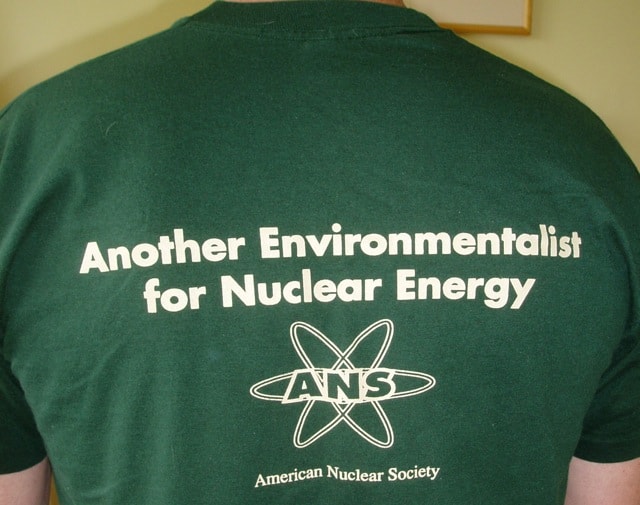Reed College has a nuclear reactor operated by undergraduate liberal arts majors
Reed College is perhaps best known among technologists as the place where Steve Jobs learned about calligraphy – among a number of other useful topics. It is also the only liberal arts college that owns a research reactor that is operated primarily by undergraduates.
I hope you enjoyed Will and Norm’s visit to the Reed Research Reactor as much as I did. It certainly breaks a few stereotypes. To learn more, visit the Reed Reactor FAQ.



Stereotype #1 – Nuke Fusion is Magic – True! we all saw the Wizard talking about how it works!!!
Very cool video thanks for posting
Was a sad day when the eco-movement shut Columbia U’s reactor down back the early ’70’s! Heck, I still can’t believe Brookhaven Labs buckled under and shut theirs down! Only gave anti’s sass and encouragement to go after Shoreham…
James Greenidge
Queens NY
It is sad to see students so poorly trained. When the sample comes back she should be at a
safe distance with a handheld detector. Instead she is seated at the glovebox.
The radiation monitor should be set to the highest scale, but it is on the lowest scale and
pegs immediately. Ignoring the monitor, she begins handling the sample with no idea how hot
it is.
I know they are just students, but that reactor produces enough neutrons to deserve respect.
I work at the reactor and I wanted to address your concerns.
If you’ll notice in the video, the radiation monitor you are referring to is a contamination meter, and guaranteed to peg out if it is exposed to a radiation field. Contamination meters are used to detect stray radioactive materials in small quantities, and this one is placed on top of the glovebox for the purpose of surveying our gloves after handling the samples. It does not measure fields and will swamp in the most minimal fields, by nature of its design as a Geiger-Muller counter.
The monitor you should actually pay attention to is the Radiation Area Monitor slightly behind the contamination meter, with a digital red readout. This meter is designed to read fields and is not alarming. The maximum amount shown in the video looks to be 1.6 mR/hr, which is a low field. Even the public is allowed to be in this field (their limit is 2 mR/hr). If this monitor were to read 10 mR/hr or above, we would put the sample in a lead casket to decay, because while these are low levels of radiation, we try to keep our radiation dose minimal. Our dosimetry reports every quarter habitually read “undetectable” for most, if not all of the operators.
Finally, our procedures call for the operator to step away in instances when either we know the sample is coming back hot (>10 mR/hr) because of our calculations, or when the operator of record (the person behind the controls) sees a power change upon insertion or removal of the sample. A power change would indicate worth being added to the core, telling us that the sample will be very hot when it comes out. Thus, the operator communicates with the sample handler that she needs to back away from the terminus.
To summarize, in this situation, the monitor alarming in the video will always alarm in the lowest of fields, the important monitor read a very minimal radiation field, and there were no power changes upon insertion and removal. Hence, it was safe to remove the sample
A similar set-up is at the Delft university of technology in the Netherlands, where I saw it. Interesting to see the SCRAM performed.
The comment in the video about the DEMI water being dangerous because of its bursting your cells: I thought that that was an urban myth. DEMI water is not dangerous, even if you drink it, or I am very much mistaken.
I hadn’t realized that it was that easy to obtain a license to operate a research in one semester. It’s difficult to judge the wisdom of safe reactor operation by students based on appearances which, depending on socio-cultural backgrounds, could lead to different opinions. Certainly a 250 kW is low but you don’t need any power to cause a significant problem. I would have felt more comfortable knowing whether the students understood the fundamentals and implications of their actions or are they relying on automatic controls to keep things safe. I would hope that the NRC’s criteria and inspections are sufficient to support such activities at our universities.
@Ed – what are you talking about? The students shown in that video have an good level of knowledge and proved it in an environment where it is easy to be nervous.
Review the last few minutes of the video again. Eighty students sign up for a year long course and a CHANCE to be allowed to take the licensing exam. Only 15 students per year out of the 80 are then allowed into the advanced program that will enable them to take the license exam. I am positive that the additional training is fairly arduous.
@ Rod, I did review the last few minutes of the video again and it does not agree with your statement. Melinda Krahenbuhl’s, the reactor director’s statement: “We have a PROGRAM THAT STARTS UP IN THE FALL. We start with about eighty students who train. They come in for a lecture once a week and a lab once a week. BY NOVEMBER OR SO WE HAVE THEM SUBMIT AN APPLICATION, unfortunately we can only license fifteen people a year.” It’s the same thing I heard the first time and upon which I based my comment “I hadn’t realized that it was that easy to obtain a license to operate a research in one semester.”
This time I went to your FAQ link:
“How does a student get a license?
… After a full academic year the students can take the license exam. The Nuclear Regulatory Commission sends out examiners from Washington, D.C. who administer a 3-hour written exam and 4-hour walkthrough-operational-oral exam.”
Maybe you got your information about a year long course before the students can take the exam from someplace else or interpolated the information from the video and the FAQ but it certainly didn’t come from either the video or the FAQ alone. Would my feelings and opinion change whatever the length of training actually is before the student took the NRC exam? Certainly not based on the video.
@Ed Knuckles
I do not understand your comment. As you wrote, students must take a course that lasts for a “full academic year”, pass a 3 hour written test, and satisfactorily complete a 4 hour walk-through administered by the US Nuclear Regulatory Commission before they are licensed to operate the 250 kilowatt, passivel-safe Triga 1 pool reactor.
That does not sound like an “easy” or inadequate qualification process to me. The video showed me that the students have a good beginner’s grasp of nuclear physics and safe reactor operation.
IMHO – is should be pretty easy to obtain a license to operate a Triga reactor. It is really a license to learn more about how simple and safe nuclear reactors can be.
Ed – Rod has covered the training, but the other thing to remember is that this is a TRIGA reactor. It was designed in the 1950’s to be so inherently safe that “even a student” could operate it safely.
Have you ever seen the Youtube video of the TRIGA reactor going prompt critical? The reactor goes from 50 watts to 340 megawatts in 30 milliseconds and then shuts itself down. In the video, you get to watch the pulse from above, looking down at the reactor in the pool.
@ Rod can’t understand my comment; well I’m talking about YOUR statement: “Review the last few minutes of the video again. Eighty students sign up for a year long course and a CHANCE to be allowed to take the licensing exam.” The video does not support YOUR statement.
@Ed Knuckles – I do not want to argue with you, but the course does last a full academic year, and the student do only have a chance (15 out of 80) of taking the license exam. I stand by my comment, even if not all of the necessary information is explicitly stated in the video.
The web site states that “we don’t use the heat for anything”. Why not? Could it not be used for space heating through a heat exchanger and also for hot water? Would set a good example and also cut the expense of gas and electricity, that might help keep the tuition down.
Why not? Probably for the same reason the nobody tries to use the waste heat from any other university lab setup — it’s simply not worth the effort.
That is, the value of the heat extracted is far lower than the cost of installing and maintaining a system to get the heat. Rather than reducing tuition, such a system would significantly raise the cost of the facility to the college.
The reactor is sitting in a pool of water. The heat goes to the pool (through natural convection) and then is removed by keeping the pool cool. To extract any meaningful heat, one would need to run pipes through the core of the reactor and then insulate the pipes to keep the heat from being transfered to the pool. This would not only make the reactor configuration more complicated, but it could likely impact the neutronics, making the reactor more challenging to operate effectively.
Also, keep in mind that the research reactor is usually not operated in a flat-out, uniform configuration like a power reactor. It is frequently taken off-line, either for inspection or maintenance or because no experiments are being run, and the reactor is sometimes run in an unusual configuration to get the proper neutron flux distribution needed for a particular experiment.
MIT did a study for their 5 MW (higher than 250 KW) reactor to see if the “waste heat” could be used for building space heating and the like. Since the MITR has a fairly constant duty cycle it made sense to at least look at it. Based on average building heating costs, the capital investment for heat exchange and transfer equipment, and the marginal savings over a year’s time, they estimated about a 60 year payback period. It was judged to be too hard of a sell to University administrators, who often seem more interested in cutting funding for URRs than supporting capital expenditures.
Its a typical problem in heat generating systems. The delta-T is just too small to make efficient heat transfer possible. Any energy you extract is pretty low quality.
That darn Carnot.
http://en.wikipedia.org/wiki/Thermal_efficiency#Carnot_efficiency